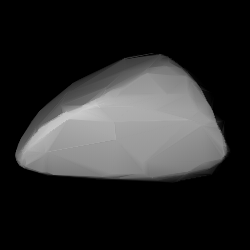1353 Maartje Last updated March 27, 2025 Asteroid
1353 Maartje , provisional designation 1935 CU , is an Eoan asteroid from the outer regions of the asteroid belt , approximately 37 kilometers in diameter. It was discovered on 13 February 1935, by Dutch astronomer Hendrik van Gent at the Union Observatory in Johannesburg, South Africa. [ 16] The asteroid was named after Maartje Mekking, daughter of a staff member at the Dutch Leiden Observatory . [ 2]
Physical characteristics Maartje has been characterized as an L- and S-type asteroid by PanSTARRS photometric survey, [ 15] while the overall spectral type of the Eos family is that of a K-type . [ 17] : 23
Rotation period and poles Lightcurve -based 3D-model of Maartje Several rotational lightcurve of Maartje have been obtained from photometric observations since 2005. [ 11] [ 12] Lightcurve analysis gave a consolidated, slightly longer-than average, and well-defined rotation period of 22.930 hours with a brightness amplitude between 0.25 and 0.46 magnitude ( U=3 ). [ 3] The asteroid's lightcurve has also been modeled and gave two concurring periods of 22.9924 and 22.9926 hours. [ 13] [ 14] [ a] Modeling in 2018 determined two spin axis of (285.0°, 73.0°) and (119.0°, 41.0°) in ecliptic coordinates (λ, β). [ 13]
Notes 1 2 Unpublished study (Hanus 2016d). See summary figures for (1353) Maartje at the LCDB References 1 2 3 4 "JPL Small-Body Database Browser: 1353 Maartje (1935 CU)" (2017-11-02 last obs.). Jet Propulsion Laboratory . Retrieved 15 November 2017 . 1 2 3 Schmadel, Lutz D. (2007). "(1353) Maartje". Dictionary of Minor Planet Names . Springer Berlin Heidelberg . p. 110. doi :10.1007/978-3-540-29925-7_1354 . ISBN 978-3-540-00238-3 1 2 3 4 5 6 7 8 "LCDB Data for (1353) Maartje" . Asteroid Lightcurve Database (LCDB). Retrieved 15 November 2017 . 1 2 "Asteroid 1353 Maartje – Nesvorny HCM Asteroid Families V3.0" . Small Bodies Data Ferret . Retrieved 26 October 2019 . 1 2 3 4 Tedesco, E. F.; Noah, P. V.; Noah, M.; Price, S. D. (October 2004). "IRAS Minor Planet Survey V6.0" . NASA Planetary Data System . 12 : IRAS-A-FPA-3-RDR-IMPS-V6.0. Bibcode :2004PDSS...12.....T . Retrieved 22 October 2019 . 1 2 3 4 Nugent, C. R.; Mainzer, A.; Bauer, J.; Cutri, R. M.; Kramer, E. A.; Grav, T.; et al. (September 2016). "NEOWISE Reactivation Mission Year Two: Asteroid Diameters and Albedos" . The Astronomical Journal . 152 (3): 12. arXiv : 1606.08923 . Bibcode :2016AJ....152...63N . doi : 10.3847/0004-6256/152/3/63 . 1 2 3 4 Usui, Fumihiko; Kuroda, Daisuke; Müller, Thomas G.; Hasegawa, Sunao; Ishiguro, Masateru; Ootsubo, Takafumi; et al. (October 2011). "Asteroid Catalog Using Akari: AKARI/IRC Mid-Infrared Asteroid Survey". Publications of the Astronomical Society of Japan . 63 (5): 1117– 1138. Bibcode :2011PASJ...63.1117U . doi :10.1093/pasj/63.5.1117 . online , AcuA catalog p. 153 ) 1 2 Masiero, Joseph R.; Grav, T.; Mainzer, A. K.; Nugent, C. R.; Bauer, J. M.; Stevenson, R.; et al. (August 2014). "Main-belt Asteroids with WISE/NEOWISE: Near-infrared Albedos" . The Astrophysical Journal . 791 (2): 11. arXiv : 1406.6645 . Bibcode :2014ApJ...791..121M . doi :10.1088/0004-637X/791/2/121 . Retrieved 15 November 2017 . 1 2 3 4 Masiero, Joseph R.; Mainzer, A. K.; Grav, T.; Bauer, J. M.; Cutri, R. M.; Nugent, C.; et al. (November 2012). "Preliminary Analysis of WISE/NEOWISE 3-Band Cryogenic and Post-cryogenic Observations of Main Belt Asteroids" . The Astrophysical Journal Letters . 759 (1): 5. arXiv : 1209.5794 . Bibcode :2012ApJ...759L...8M . doi :10.1088/2041-8205/759/1/L8 . Retrieved 15 November 2017 . 1 2 3 4 Mainzer, A.; Grav, T.; Masiero, J.; Hand, E.; Bauer, J.; Tholen, D.; et al. (November 2011). "NEOWISE Studies of Spectrophotometrically Classified Asteroids: Preliminary Results". The Astrophysical Journal . 741 (2): 25. arXiv : 1109.6407 . Bibcode :2011ApJ...741...90M . doi :10.1088/0004-637X/741/2/90 . 1 2 3 4 Behrend, Raoul. "Asteroids and comets rotation curves – (1353) Maartje" . Geneva Observatory. Retrieved 15 November 2017 . 1 2 Garceran, Alfonso Carreno; Aznar, Amadeo; Mansego, Enrique Arce; Rodriguez, Pedro Brines; de Haro, Juan Lozano; Silva, Alvaro Fornas; et al. (January 2016). "Nineteen Asteroids Lightcurves at Asteroids Observers (OBAS) - MPPD: 2015 April - September" . The Minor Planet Bulletin . 43 (1): 92– 97. Bibcode :2016MPBu...43...92G . ISSN 1052-8091 . Retrieved 15 November 2017 . 1 2 3 Hanus, J.; Delbo', M.; Alí-Lagoa, V.; Bolin, B.; Jedicke, R.; Durech, J.; et al. (January 2018). "Spin states of asteroids in the Eos collisional family". Icarus . 299 : 84– 96. arXiv : 1707.05507 . Bibcode :2018Icar..299...84H . doi :10.1016/j.icarus.2017.07.007 . 1 2 Hanus, J.; Broz, M.; Durech, J.; Warner, B. D.; Brinsfield, J.; Durkee, R.; et al. (November 2013). "An anisotropic distribution of spin vectors in asteroid families" . Astronomy and Astrophysics . 559 : 19. arXiv : 1309.4296 . Bibcode :2013A& A...559A.134H . doi :10.1051/0004-6361/201321993 . Retrieved 15 November 2017 . 1 2 3 Veres, Peter; Jedicke, Robert; Fitzsimmons, Alan; Denneau, Larry; Granvik, Mikael; Bolin, Bryce; et al. (November 2015). "Absolute magnitudes and slope parameters for 250,000 asteroids observed by Pan-STARRS PS1 - Preliminary results" . Icarus . 261 : 34– 47. arXiv : 1506.00762 . Bibcode :2015Icar..261...34V . doi :10.1016/j.icarus.2015.08.007 . Retrieved 15 November 2017 . 1 2 "1353 Maartje (1935 CU)" . Minor Planet Center . Retrieved 15 November 2017 . 1 2 Nesvorný, D.; Broz, M.; Carruba, V. (December 2014). "Identification and Dynamical Properties of Asteroid Families". Asteroids IV . pp. 297– 321. arXiv : 1502.01628 . Bibcode :2015aste.book..297N . doi :10.2458/azu_uapress_9780816532131-ch016 . ISBN 9780816532131 This page is based on this
Wikipedia article Text is available under the
CC BY-SA 4.0 license; additional terms may apply.
Images, videos and audio are available under their respective licenses.

